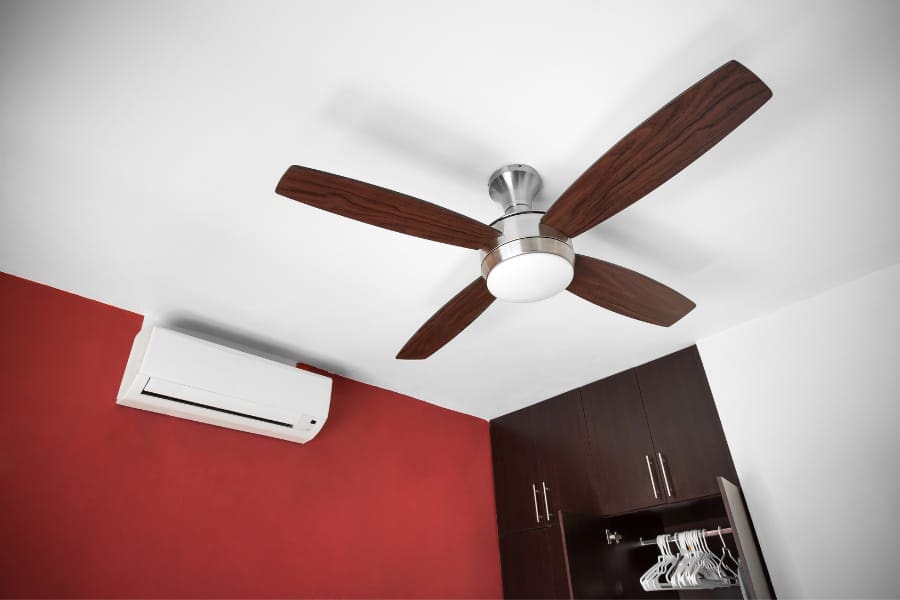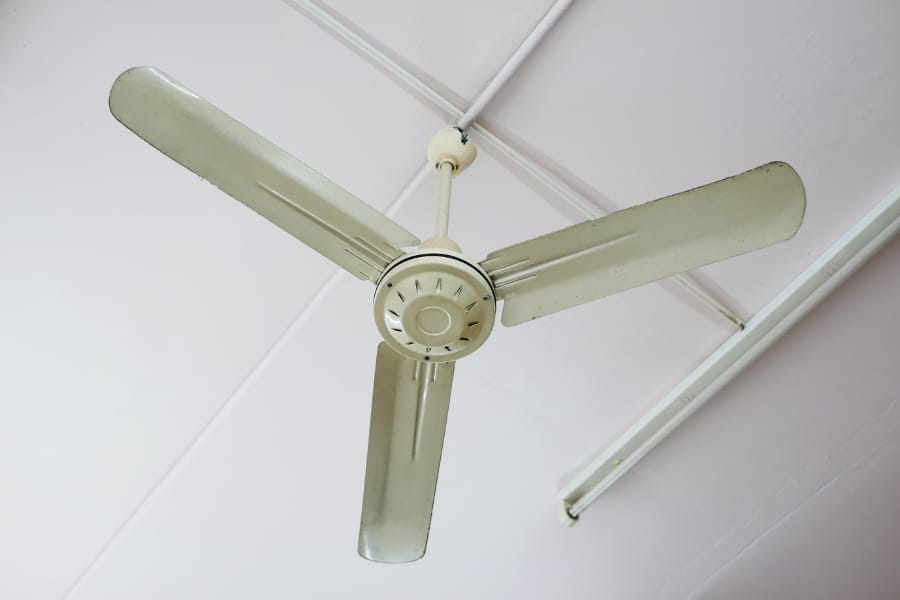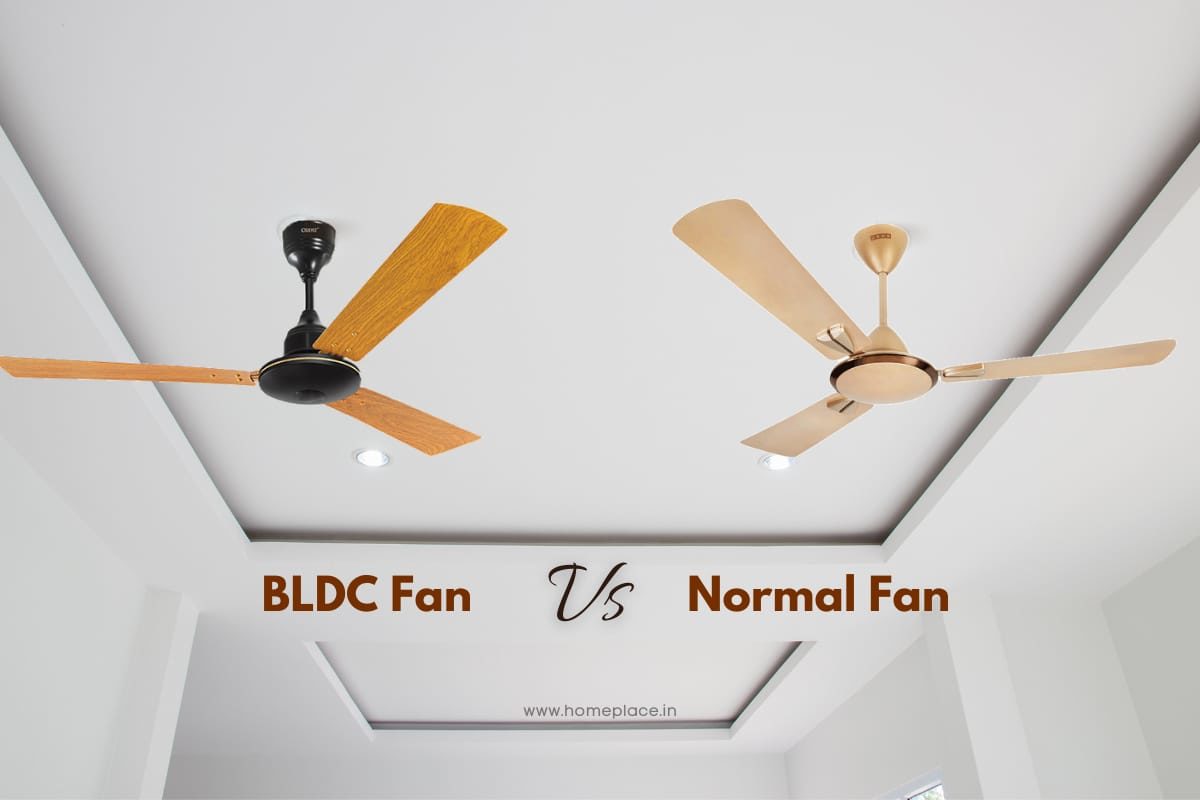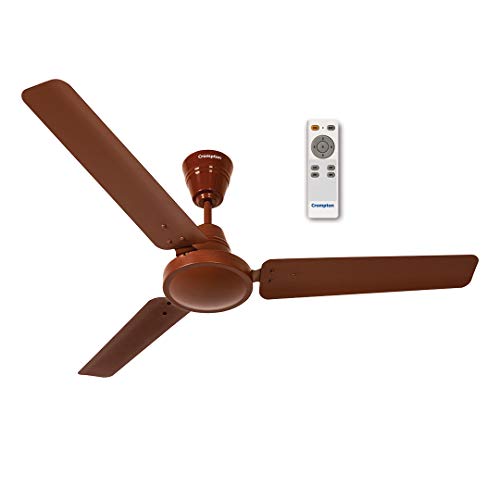BLDC fan or Brushless Direct Current Motor fan is a new innovation in the market. While comparing BLDC fan vs Normal fan, one must know that BLDC motor utilizes permanent magnets in place of conventional motors’ electromagnets and are commutated electronically. Permanent magnets have lesser heat and energy losses in comparison to electromagnets.
BLDC motors can reduce power consumption by up to 65% compared to the usual induction motors. Again, a BLDC ceiling fan’s lifespan is more than a normal ceiling fan because the BLDC motor generates no heat or noise. So, it augments the longevity of the fan bearings. As a result, this alters the ceiling fans into modern appliances that can merge well with today’s smart homes.
In the fans industry, BLDC has become a new revolution. These fans are hugely utilized in industries that need high-torque motors. In the coming years, it is expected that all inefficient and old induction motor fans will be substituted by super-efficient and smart BLDC fans.
So, let’s dive into an in-depth analysis of the comparative differences between BLDC and normal ceiling fans.
What Is A BLDC Fan?
BLDC fans are an integration of normal fans with the latest technology that gives superior performance and excellent results. BLDC motors convert electrical energy into mechanical energy by rotating the fan with higher efficiency than ordinary fan motors.
Due to the absence of brushes, the motor shaft does not create friction that eliminates the possibility of losing energy. Nowadays, several industries are manufacturing BLDC motors, and top companies use BLDC motors for their best ceiling fans available.
Like ordinary fans, BLDC fans are not available in many types. BLDC ceiling fans and stand fans are the most popular and value for money though they are costly.

Advantages Of BLDC Fans
Disadvantages Of BLDC Fans
When Should You Choose A BLDC Fan Over A Normal Fan?
A normal fan contains a single-phase induction motor, but a BLDC fan uses a brushless electronic DC motor. The material utilized in the making and wiring of these normal fans is inexpensive but not as efficient as BLDC fans.
On the contrary, the BLDC ceiling fan manufacturers utilize copper wiring. Compared to the standard fans that consume 70-80 W of electricity, the energy-efficient and modern BLDC fans use 20-35 W, nearly 65% less. Because brushless DC motors possess a higher torque to weight ratio, a BLDC fan turns into an energy-efficient choice for people.
Our Recommendations For BLDC Fan
If you prefer to buy a BLDC fan, look no further than the top 3 products- Atomberg Renesa, Orient Electric I-Tome, and Crompton Energion. The power consumption of these fans varies from 26 Watts to 35 Watts. Also, they rotate at 340-370 RPM speed, with the air delivery ranging from 220 CMM to 230 CMM. Overall, these BLDC ceiling fans are the best choices one can make.
What Is A Normal Fan?
A normal fan is nothing but an ordinary fan with simple induction motors. The most important thing is an ordinary fan is used for general purposes and is inexpensive. These fans provide a sufficient amount of comfort to people but generate noise and consume more electricity.
So, it is vital to understand that such fans are ideal for regular use, and they must be in a well-maintained state to give a fresh breeze. Also, the doors and windows of the rooms must be airy and open for their optimum performance.
These fans are available in various designs- ceiling fans, table fans, pedestal fans, wall-mounted fans, and exhaust fans. Each of these types of fans has different purposes in different conditions.

Advantages Of A Normal Fan
Disadvantages Of Normal Fans
When Should You Choose A Normal Fan Over A BLDC Fan?
A normal fan is a more budget-friendly alternative to a BLDC fan. Many people choose regular fans over BLDC fans when they have financial constraints. Apart from it, fans with normal induction motors are also available in various designs, which BLDC fans lack. So, if you have any of these requirements, you can choose a normal fan over a BLDC fan.
Our Recommendations For normal Fan
If you choose to buy a normal fan, these top 3 products are the best choices- Havells Nicola, Crompton Hill Briz, and Usha Racer. The power consumption of these fans varies from 74 Watts to 78 Watts. Also, they rotate at 370-400 RPM speed, with the air delivery ranging from 205 CMM to 220 CMM. Therefore, these fans are the best choices in the category of normal fans.

BLDC Fan vs Normal Fan Comparison
| Point of Difference | BLDC Fan | Normal Fan |
|---|---|---|
| Motor Design | The noise level of a normal fan ranges from 30-70 DB (A) based on the model, like ceiling, wall-mounted, industrial, stand, or pedestal fans. | In a BLDC motor, there isn’t any brush between the stator and rotor to transfer the electricity supply. |
| Power Consumption | BLDC fans consume 20-35 Watts of energy which is lower than any other fans. | A normal ceiling fan has rated power between 70-75 Watts which is higher than BLDC fans. |
| Inverter Compatibility | A BLDC fan consumes the least energy when it runs on an inverter power system. | Normal fans draw more electricity from the inverter battery during power cuts. |
| Speed Control | To regulate an ordinary fan’s speed, you must use traditional power switches and regulators. Some latest fans also come with remote control. | BLDC fans are noiseless due to the absence of brushes around the motor shaft. |
| Air Delivery | BLDC fans have air delivery in the range of 220-270 CMM. | The air delivery of a normal ceiling fan is around 200-230 CMM. |
| Noise Level | The noise level of a normal fan ranges from 30-70 DB (A) based on the model, like ceiling, wall-mounted, industrial, stand, or pedestal fans. | The noise level of a normal fan ranges from 30-70 db(A) based on the model, like ceiling, wall-mounted, industrial, stand, or pedestal fans. |
| Price | ₹2000 to ₹6000 | ₹800 to ₹4000 |
Differences And Similarities Of BLDC And Normal Fan
Design of motor
BLDC fans are equipped with brushless DC (BLDC) motors. Without mechanical brushes, these motors have a higher power-to-weight and torque ratio. Additionally, they run efficiently in comparison to the brushed DC motors. There isn’t any friction loss of rotational energy in BLDC fans, so they deliver higher efficiency over an induction motor.
A single-phase induction motor is utilized in standard ceiling fans. These induction motors need only one power phase, changing electrical energy into mechanical energy. Ordinary fan motors contain brushes that lack the benefits of BLDC systems.
BLDC fan vs normal fan power consumption
The BLDC fans use 20-35 Watts of power for running. Utilization of permanent magnet and brushless mechanism in BLDC motors results in lower power consumption. However, the power requirements of BLDC fans tend to change, and when there is a lesser speed, it results in lower energy consumption too. These fans even consume less energy than air coolers too.
For example, the Atomberg Renesa BLDC Ceiling Fan has a rated power of 28 Watts. If you use the fan for 18 hours a day, it will consume 0.5 kWh of energy. If the electricity tariff is ₹6/unit, this ceiling fan will cost you bills of only ₹90 a month.
On the other hand, normal fans use an induction motor, and they consume 70-75 Watts of electricity for operating normally. However, this energy requirement remains constant when operating it at different speeds.
For instance, Crompton Hill Briz High-Speed Ceiling Fan comes with a power rating of 75 Watts. After running for 18 hours a day, it will need 1.35 kWh of electricity. For the same tariff of ₹6/unit, Crompton Hill Briz will cause you monthly electricity bills of ₹243.
| Parameters* | Atomberg Renesa | Crompton Hill Briz |
|---|---|---|
| Type Of Fan | BLDC | Normal |
| Market Price (Approx.) | ₹3400 | ₹1500 |
| Power Rating | 28 Watts | 75 Watts |
| Hourly Power Consumption | 0.028 kWh | 0.075 kWh |
| Daily Power Consumption | 0.5 kWh | 1.35 kWh |
| Monthly Power Consumption | 15 kWh | 40.5 kWh |
| Yearly Power Consumption | 180 kWh | 486 kWh |
| Monthly Electricity Bill | ₹90 | ₹243 |
| Yearly Electricity Bill | ₹1080 | ₹2916 |
| Total Cost (1st Year) | ₹4480 | ₹4416 |
| Monetary Savings (1st Year) | -₹64 | +₹64 |
| Total Cost (2nd Year) | ₹1144 | ₹2916 |
| Monetary Savings (2nd Year) | +₹1772 | -₹1772 |
* The electricity tariff is considered as ₹6/unit and run time as 18 hours.
The above table shows details of power consumption, electricity cost, and monetary savings of using the two fans. If you buy Atomberg Renesa, you can recover the differences in their costs after 13 months and save ₹1772 second year onwards.
So, compared to the BLDC fan’s electricity bill, the cost of running a normal fan is almost thrice. For this reason, installing a BLDC fan is always preferable.
Inverter compatibility of BLDC fans and regular fans
A BLDC fan provides a longer backup on inverters as it draws less electricity. BLDC fans run on DC motors and thus have got an inbuilt inverter to change AC supply to DC. For this reason, you can also use it in a solar-connected system.
You can run any normal fan with a 150 Watts inverter, but as these fans draw more electricity than BLDC fans, the power backup would be slightly less. Whether you have a table fan, ceiling fan, wall fan, or pedestal fan, you will not require too much power.
Also Read: Table Fan Vs Ceiling Fan Power Consumption
BLDC fan vs normal fan speed
To compare the speed of BLDC and normal fans, you must know that the duty cycle of a constant PWM (pulse-width modulation) signal controls the speed of a BLDC fan. It is applied to the outer switching device. When you amplify the percentage of the PWM signal’s duty cycle, you can increase the speed of your fan.
You can operate BLDC fans by using a remote control, smartphone app, and manual switches. The previous example- Atomberg Renesa BLDC Ceiling Fan comes with 6 speeds with variable RPM.
On the other hand, controlling a normal fan’s speed is as straightforward as you just need to switch it on and use the regulator to adjust the rotational speed. However, some modern ceiling fans also come with remote control systems.
Air Delivery and air throw
Before you buy a ceiling fan, you need to know the air delivery and air throw it offers. The air delivery rate of BLDC fans ranges between 220 CMM and 270 CMM, whereas a typical fan has an air delivery rate ranging between 200 CMM and 230 CMM.
The air throw of most BLDC fans is satisfactory, whereas you have to trust specific brands and products in the case of normal fans.
Normal fan vs BLDC fan noise
A BLDC fan has the sturdiest motors, allowing silent and smooth operation. These fans run at higher RPM with almost zero noise because the BLDC motor does not contain brushes. A well-tuned BLDC fan is considered the most energy-efficient and noiseless fan available.
On the other hand, the nose level of ordinary fans ranges from 30-70 dB(A) based on the model. Due to this reason, big fans are installed in unused or isolated rooms. Nonetheless, improvements related to noise reduction are made by using superior designs.
Which fan is more affordable?
Fans with BLDC motors are costlier than ordinary fans. The minimum cost of BLDC fans starts at nearly ₹2000, whereas a normal fan costs at least ₹800. For this reason, if you are looking for a budget-friendly solution, a normal fan is a better choice.
BLDC Fan Vs Normal Fan – Which Is Better And Why?
While most of us utilize normal fans during scorching summers, fans with BLDC motors are still new in the market. Built with BLDC and ordinary induction motors, BLDC fans and normal fans primarily differ in air delivery, affordability, and power consumption.
Some other remarkable benefits that you can get from buying a BLDC fan are greater torque, increased reliability, longer lifetime, and, indeed, low noise. So, a BLDC fan scores better than a normal fan in terms of technology, speed, power consumption, lifespan, and different other parameters.
On the other hand, a normal fan is more budget-friendly and available with a lot more designs than BLDC fans. However, considering the overall features, benefits, and limitations, it is evident that BLDC fans are a better choice than normal fans.
Last update on 2024-04-17 / Affiliate links / Images from Amazon Product Advertising API






